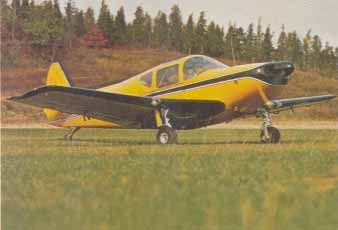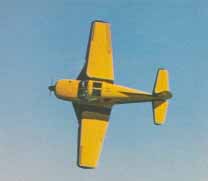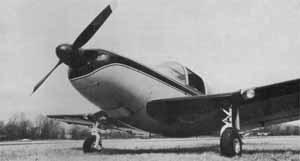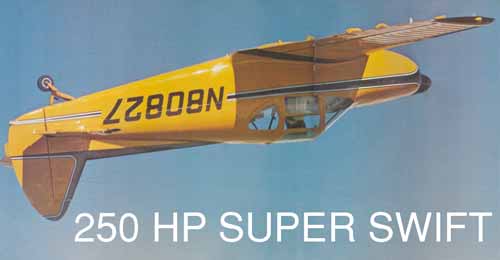PAGE TWO
 |
The airplane now has a Nagle
canopy and a 540 Lycoming in it, but the certification is still
hung up. |
It took some time to get used to the power settings the Franklin demanded.
Full power is a whopping 39 inches of manifold pressure and 2800 rpm,
with 43 inches permissible for five minutes at a time. Numbers
like that belong in a fighter, homemade or not. We leveled out at 4,000
feet and cranked in 75 percent power. The airspeed settled down to
a solid 190 mph indicated or an amazing 204 mph true! Sixty-five percent
gave 175 mph IAS and economy cruise was 165 IAS (177 TAS) at less than
10 gph. Steve has had it as high as 16,000 feet and says the indicated
speeds don't change a bit because of the turbocharger. That means it's
capable of whistling along in cruise at 235 mph TAS or better.
The AiResearch turbocharger that's puffing into this Franklin has to
be one of the slickest around. It's hooked to the throttle and comes
in via mechanical linkage when the throttle gets more than
three-quarters open, so you just fly as you would normally and let
the turbo take care of itself. In the 150 hours Steve has logged on
the airplane, ironing out bugs as he went, the turbo hasn't so much
as hiccupped. It's been completely trouble free.
A stock Swift feels like a fighter anyway, but when you have this many
ponies working for you, and you know both the engine and airframe are
specially built for hanging upside down, there's no way
this thing can stay right side up for long. The Bonanza tips reduced
the wingspan almost five feet, so the already high roll rate is jacked
up to the point that full-deflection aileron rolls bounce your head
off the side windows. All the controls are silky smooth and respond
to every touch, no matter how subtle.
 |
The airplane does amazingly
good high-speed aerobatics |
I looped and rolled and twisted and turned for a while and found the
airplane to be nearly as capable as my Pitts, but requiring more airspace
and a little lighter touch when slow. But, somehow, I didn't feel I
was really getting to know the airplane. Sure, I was tossing
it around a lot, but even though it did precision aerobatics with the
very best of them, it felt as if it would have been happier doing something
else. Then the opportunity presented itself to really find
out how the airplane flies.
During one of our rare lapses into level
flight, I glanced over my right shoulder just in time to see a friend
of mine, Harry Sheppard, glue himself into our four o'clock position
in his gleaming white Waco Meteor, known in Europe as the Siai-Marchetti
S F. 260. Sheppard is an ex-Navy fighter jockey and the
S F. 260 is probably the fastest single-engine production
airplane in the world, besides being aerobatic. This was just too good
to miss.
From the grin on his face I knew what was in his mind, so I pulled
up hard into a big right-hand barrel roll, watching the Meteor through
the Swift's top canopy as Harry started to turn away—the fight
was on. The G meter scrambled toward plus-4 as I pulled out of the
roll, trying to keep behind the Meteor, which was going to be tough
because Sheppard is so good at this game, I knew he’d be humoring
me to even let me stay in the same piece of sky with him during a dogfight.
The fight raged on for 15 minutes, going from 2,000 to 6,000 feet and
back in seconds. It made no difference who won (I say that because
I lost) because we were both having a ball, and I got to stuff the
Swift into every little nook and cranny of its flight envelope.
I learned a lot about it while hassling Harry. While following the
Meteor up out of 250-mph dives, I found the Swift loses speed in the
vertical much faster than I expected, although it goes uphill
for a long, long way. I was vertical at the top of one of those 2,500
foot zooms and in the process of rotating 90 degrees to
pull over on my back when I glanced at the airspeed. It was hovering
around 55 mph and I was still under perfect control.
 |
Tough looking little toad,
isn't it? |
The Swift surprised me almost immediately during my first
4G turn onto the Meteor's tail when it started buffetting
like crazy, telling me I was nibbling at a high speed stall,
even though I was indicating over 150 mph. That's where the extra wing
area of the original tips would have helped. A couple times
I accidentally got it quite deep into the buffet but it kept right
on flying and give no indication that it was going to do
anything stupid. Soon, I formed the habit of pulling until I felt the
buffet and then backing off just a bit. Normal stalls were preceded
by the same shaking and shimmying.
There is no more satisfying, exhilarating sport than dogfighting
with two well-built aerobatic machines, especially when
the pilots have flown enough together to trust each other and both
know to keep out of the other's way. In a good free-for-all you do
practically no aerobatics in the formal sense of the word. The horizon
ceases to exist and you are judging all your movements by the airplane
that's hopefully in front of you (although in my case I was looking
over my shoulder most of the time). It's complete three-dimensional
flight. In airplanes such as the Halpern/ D'Arcy Swift or the S F.
260, the airplane offers no limitations, so all you have to remember
is not to hit the ground or each other. This is the game the big Swift
is best at—it let me play fighter pilot in the truest sense of
the word, at less than 18 gph. It's really a blast!
The landings were probably the biggest surprise of all.
I found it easier to land than a stock Swift. The wing fillets allowed
me to creep over the fence at 75 to 80 mph, and even a couple mph too
much gives a tremendous float. It must have something to do with the
way the fillets streamline the airflow over the gear well or something,
because it sure is a floater. Once it's down, though, the clipped wings
make sure it's going to stay there. The shorter wings also make it
easier to three-point, although I wheel-landed it because I'm basically
a chicken. Wheelies are dead simple. I made quite a few takeoffs and
landings and found both to be no sweat. It has the normal Swift problems
such as being difficult to handle in hard left crosswinds on takeoff,
but nothing that's any more than a minor irritation. A crosswind doesn't
seem to make much difference on landing because the little wings are
so close to the ground and the gear is so wide that it's easy to control
with rudder and/or brakes.
To put it simply, the 250-hp Turbo Swift has the performance of a fighter,
the agility of an acrobat and the docile handling characteristics of
a Cub. You can run right past most twins inverted, while only sipping
fuel instead of guzzling it, and then push up into an outside
loop. It's such a pretty little thing, and has so many obvious advantages,
that anybody who wants something more than just another flying machine
would be satisfied with it.
The airport vibrated to the sound of the Franklin pulling Halpern up
at a 45-degree angle. I watched him disappearing in the
distance, the wing tips occasionally swapping places as he rolled,
and I started thinking, "Let's see. I know where I can get a good
Swift airframe, then I need a Franklin, and ..." BD
Editor's Note from 2009: Steve still has the airplane and has continually
modified it through the years. It now has a central control stick with the throttle,
prop and flaps on the stick run by electric motors. He's mounted a Nagle canopy
and put a Lycoming 0-540 in it. However, he's trying to keep it in standard category
and the individual doing the certification has been slow getting it done. But,
he won't give up: Steve is nothing if not persistent.
For more pilot reports like this one go to PILOT
REPORTS.
|

